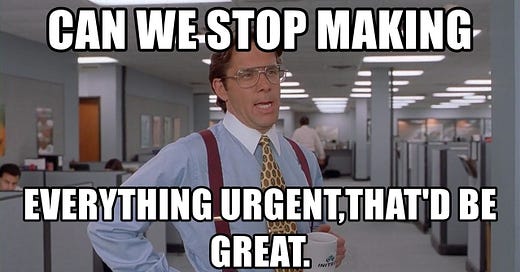Short Stuff: What To Do When Everything is "Important".
A Short and Simple Guide to Staying Sane As a Product Manager
We've all been there. You're working with stakeholders who are passionate about the product (which is great!). But somehow, every feature, tweak, and new idea they have is labeled as "urgent," "critical," or the dreaded "P0 priority."
As a product manager, it's your job to balance these requests against the realities of limited time, resources, and the overarching product strategy. Saying "no" outright often isn't a winning move. So, how do you navigate this without throwing your roadmap or strategy out the window?
"Everything is P0" – The Underlying Problem
Stakeholders who have a sense of urgency about everything usually fall into a few categories:
The Visionaries: They're bursting with big ideas but might lack a grasp of the practical limitations of development.
The Problem-Solvers: They've correctly identified real user pain points but see every solution as needing immediate attention.
The Competitors-Keep-Me-Up-At-Night Crowd: They're hyper-focused on what rivals are doing and want immediate feature parity.
The Squeaky Wheels: They're the loudest voices, demanding attention based on who they are rather than the true strategic value of their request.
The problem isn't that these stakeholders have bad intentions. It's that "P0" loses all meaning when overused, making true prioritization impossible.
The "OK, But Stack Rank" Strategy
The oft-quoted advice to ask for a stack ranking of all those "P0" priorities is on the right track, but it needs some finesse. Here's how to use this tactic effectively:
Acknowledge, Don't Dismiss: Start by validating their enthusiasm. "I love that you're so excited about these ideas! It sounds like we have some impactful changes we could make." This disarms defensiveness.
Shift the Focus to Goals: "To make sure we're on the same page, can we take a step back and revisit our high-level goals for this quarter/product cycle?" Tie this back to business objectives or user metrics.
Introduce the Stack Ranking: "It sounds like we have more potential top priorities than we can realistically tackle at once. Could you help me prioritize these against our goals? If we had to choose just one or two to focus on first..."
Ask the Hard Questions: This is where you steer the conversation:
"What impact will this have on [key metric]?"
"How many users will this truly benefit?"
"What's the downside if we delay this by a sprint or two?"
It's Not Just About Saying No, It's About Saying "Yes, But..."
The goal isn't to shut down your stakeholders' ideas entirely, but to guide them towards a more sustainable and strategic approach. Here are some ways to reframe the conversation:
"Yes, and...": "I agree this is important, and here's how it might fit in after we achieve [current focus]. Would you be open to revisiting this in a few weeks?"
"Yes, if...": "This could be fantastic if we can secure additional resources/have a simplified version for our MVP. Let's explore what that would look like."
"Yes, with your help...": "Absolutely a priority, but I'll need your help advocating for more dev support/getting early user feedback. Are you willing to partner on that?"
Beyond Individual Conversations: Building a Culture of Prioritization
True change doesn't happen in a single meeting. Here's how you can proactively shape a more effective environment:
Visibility & Transparency: Make your roadmap and prioritization process accessible. This builds trust and preempts some "urgent" requests.
Data as Your Ally: Use analytics, user research, and past results to ground discussions in reality, not just opinions.
Celebrate the Wins: When a well-prioritized launch succeeds, make a point of highlighting how that strategic focus paid off.
Invite Collaboration, Not Just Demands: Set up regular "ideation" sessions with stakeholders, separate from immediate implementation discussions.
When to Stand Firm (Yes, Sometimes "No" is Necessary)
Prioritization is about nuance, but there are times when a firm "no" (or at least a "not right now") is in the best interest of your product. That includes:
Scope Creep on Core Features: If a request fundamentally alters the agreed-upon MVP or requirement.
Band-Aid Fixes: If the problem is a symptom of a deeper technical or UX issue that needs a larger solution.
Chasing Shiny Objects: If it's a clear reaction to a competitor but doesn't align with your user needs.
Remember: You're the Product Champion
It's easy to feel overwhelmed by stakeholder demands. But remember, you are the one with a holistic view of the product, its users, and the company's capabilities. By guiding stakeholders towards a shared understanding of true prioritization, you'll create a stronger product and a healthier working relationship for everyone involved.
I’d like to hear from you. What topic would you like me to write about next? You can leave a comment or email me directly at koopernanya@gmail.com or theproductgist@gmail.com
Take care!




